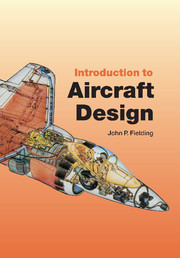Book contents
- Frontmatter
- Contents
- Preface
- Acknowledgements
- 1 Introduction
- 2 Why should we design a new aircraft?
- 3 Why is it that shape? – Civil aircraft
- 4 Why is it that shape? – Other types
- 5 What's under the skin? – Structure and propulsion
- 6 What's under the skin? – Airframe systems
- 7 What's under the skin? – Avionics, flight control and weapon systems
- 8 Why do aircraft cost so much?
- 9 What help can I get? – Bibliography and computer-aided design
- 10 The shape of things to come – Should the project continue?
- 11 What can go wrong? – Some lessons from past aircraft projects, and a glimpse into the future
- Appendix A Useful aircraft design data
- Appendix B A–90 parametric study. Example – the A-90 500-seat airliner
- Appendix C The prediction of aircraft reliability and maintainability targets
- References
- Index
3 - Why is it that shape? – Civil aircraft
- Frontmatter
- Contents
- Preface
- Acknowledgements
- 1 Introduction
- 2 Why should we design a new aircraft?
- 3 Why is it that shape? – Civil aircraft
- 4 Why is it that shape? – Other types
- 5 What's under the skin? – Structure and propulsion
- 6 What's under the skin? – Airframe systems
- 7 What's under the skin? – Avionics, flight control and weapon systems
- 8 Why do aircraft cost so much?
- 9 What help can I get? – Bibliography and computer-aided design
- 10 The shape of things to come – Should the project continue?
- 11 What can go wrong? – Some lessons from past aircraft projects, and a glimpse into the future
- Appendix A Useful aircraft design data
- Appendix B A–90 parametric study. Example – the A-90 500-seat airliner
- Appendix C The prediction of aircraft reliability and maintainability targets
- References
- Index
Summary
Background
There is almost no limit to the variety of the shapes of aircraft that have been conceived. This chapter will give a brief introduction describing wing, fuselage and powerplant arrangements followed by descriptions of the characteristics of civil, military and rotorcraft types.
Aircraft are essentially aerodynamic vehicles and every aircraft designer must develop considerable aerodynamic skills. This book is not aimed at providing those, as there are many excellent texts available, as shown in the bibliography section of this book. Appendix A6 contains some limited information to enable the evaluation of simple aerodynamic predictions for use during the conceptual design process.
The aerodynamic shape of the aircraft will determine aircraft speeds, manoeuvrability, flying qualities, range, field performance, costs, altitudes and many other parameters. There is a close interaction between such disciplines as aerodynamics, structures, propulsion and aircraft systems. For example, a high subsonic aircraft usually requires a very thin or swept wing, or a combination of these, to achieve low aerodynamic drag. Thin or swept wings adversely affect weight and may require more thrust from the propulsion system. A good compromise is therefore required. An optimum shape must be determined to maximize a chosen performance parameter. This may be minimum life cycle cost, initial cost, weight, fuel burn, etc. depending upon the type of aircraft required. In all cases, however, a good aerodynamic shape is vital, as in the areas now described.
- Type
- Chapter
- Information
- Introduction to Aircraft Design , pp. 19 - 36Publisher: Cambridge University PressPrint publication year: 1999



